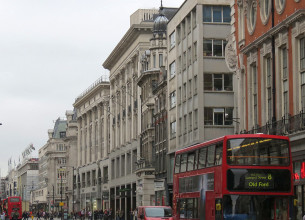 Looking towards Oxford Circus from the east.
Looking towards Oxford Circus from the east.
 Looking towards Oxford Circus from the east.
Looking towards Oxford Circus from the east.
This page describes the architectural sculpture along Oxford Street, going east from Oxford Circus towards Centre Point. We are not expecting anything grand, but a range of interesting minor decorative sculpture, which would be quite noticed were it not dwarfed by such large buildings, and ignored by people intent only on shopping. But along the way, we can see the typical late 19th Century style used on Oxford Street, with minor decorative carving and a variety of pleasing towers and domes; the grand former Waring and Gillow store, good terra cotta work including rare terra cotta beaver statues, and a variety of little heads, on keystones and in roundels and in relief. Without having any single important piece of sculpture, we can appreciate a range of late Victorian embellishments to architecture appropriate for one of the capital’s premier shopping streets. A separate page goes West from Oxford Circus.
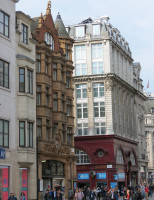
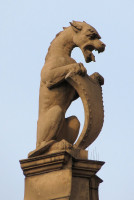
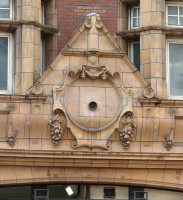 223 Oxford Street, and terra cotta details.
223 Oxford Street, and terra cotta details.
We go east from Oxford Circus, (noted on the accompanying page describing sculpture on the western portion of Oxford Street through to Selfridges and Marble Arch), away from Regent Street, mostly on the south. On the south side, Oxford Circus Station has the characteristic burgundy tiles used by the Metropolitan railway. Across Argyle Street, the Exit only bit of the Station, no. 223 Oxford Street, is clad entirely in pinky terra cotta, with over the exit a moulding of a cartouche with hanging fruits, and high up, a tower with conical roof to the corner, and next to it, a gable with a small dragon holding a shield – a not uncommon terra cotta motif used on tall west end commercial buildings and blocks of flats.
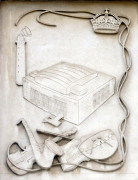
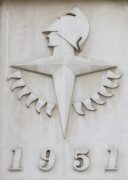
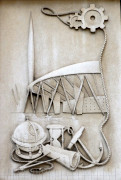 Panels for the 1951 Exhibition, no. 215 Oxford Street.
Panels for the 1951 Exhibition, no. 215 Oxford Street.
A little along, No. 215 by Hills Place is a bland modern infill, but bearing three sculptured panels relating to the 1951 Exhibition: a time of optimism in the machine age. The first panel shows what looks like an early photocopier but is in fact the Royal Festival Hall with jazz instruments and the crown; the second is iconic imagery of the period; and the third combines symbols of navigation with modern architecture and a fantastically elegant space rocket known as 'Skylon' which was an engineering feature of the Festival, next to an another feature called the Dome of Discovery (thanks to Guy Royston for supplying this information).
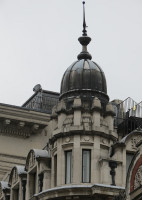
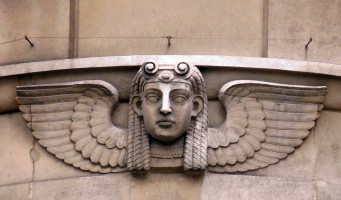
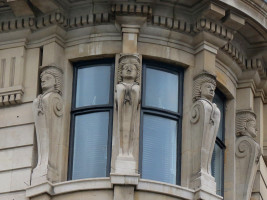 No.196 Oxford Street, the Egyptian tendancy.
No.196 Oxford Street, the Egyptian tendancy.
On the opposite, northern side of Oxford Street, the first range with its giant pillars is simply a continuation of the Circus architecture, but No. 196, HSBC, is an interesting little corner building, just four bays wide, the fourth one being the corner, with a nice onion dome on top. It is shown in the picture at the top of this page – you will need to click to enlarge to see it. Oxford Circus is about ¼ in from the left hand side, with the green mansard roof, then there are a contemporary and a more modern building keeping the lines of the Circus with the giant pilasters, and just about in the centre is the little dome of No 196, illustrated in detail below. Above each bay at second floor level is carved a small winged Egyptian head, perfectly symmetrical, and on the fourth floor at the corner, each window is separated with an attached pillar with a female Egyptian head. The head is part way down the pillar rather than at the top, and this is because the sculptor has wanted to keep the height proportional to that of a person: the base of the pillar is thus the foot, and the curvature of the pillar is at chest height, giving a rather busty appearance. These are reduced versions of caryatids – statues of girls in place of pillars – and the genre is described on this page.
We might note that across the alleyway, the next block starts with a red brick and white stone building – Russell and Bromley now – with minor decorative carving; this Queen Anneish style, though much replaced, was at one time the characteristic style for Oxford Street, and we will see quite a few more.
R. Frank Atkinson's Waring and Gillow Building, 164-188 Oxford Street, and sculptural details.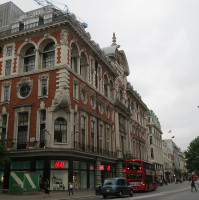
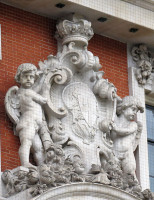
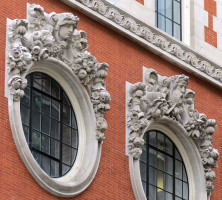
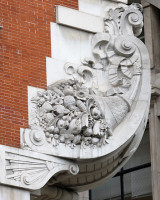
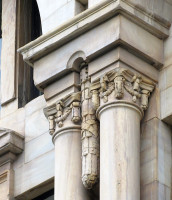
But there is one special Queen Anne building on Oxford Street, massive, grand, and profusely decorated with sculpture, filling the whole block between Great Titchfield Street and Winsley Street: this is the former Waring and Gillow Building, at Nos. 164-188 Oxford Street. It was once the grandest of furniture makers, manufacturing in Lancaster and Liverpool, and fitting out grand hotels, luxury ocean liners, and furnishing the houses of the very well off. The architect was R. Frank Atkinson, and the date on the building is 1905. Four storeys high with two further dormer storeys, the sculptural interest comes above the first floor level at the corners and above the principal entrance, above the second floor windows, and higher up, again at the corners and in the centre. The best sculpture is that above the second floor round windows, each of which has a great festoon of carved flowers and fruits pouring down each side, which emanate from small cornucopias which are not particularly evident in the fructifying mass, and at the top of each window, a sculpted head. These go round the sides of the block onto the side streets too, where the horns of the cornucopia are more easy to see.
The variety is impressive – grapes, pomegranate, apple, pineapple, corn on the cob, peas, sunflower, popy, roses, corn and acorns, and others. And the heads are equally various – mixed male and female, varying from the conventional to the exotic, including turbaned men, one with an owl on his turban, a girl with a remarkable bulging headdress, a Mercury, and a man crowned in oak leaves. The ship’s prows at the corners bear further cornucopias, and the central shield is supported by two plump winged cherubs (see this page if you like such things; for ship sculpture see this page). Most inventive, and a highly skilled but unfortunately anonymous sculptor.
T.E. Collcutt's no.181-183 Oxford Street, and details in relief - fauns, putti musician.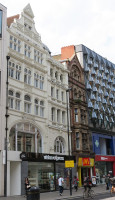
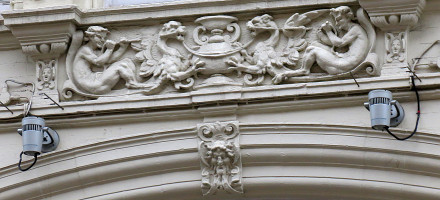
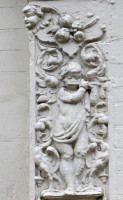
Opposite Waring and Gillow on the south side of Oxford Street, more or less in the centre of the block, is a red brick and pink terra cotta building rather like the Station exit we saw, and next to this, no. 181-183, unfortunately painted white now, contains little bands of moulded high relief sculpture: fauns play pipes to grotesque birds, plump cherubs hold drapery above the face of a smiling jester, other winged cherubs hold festoons of flowers and drapery, on what presumably was built originally as a place of entertainment. The building is a minor work by the interesting (from an architectural sculpture point of view) architect T. E. Collcott, designer of the Athenaeum in Waterloo Place among various other buildings.
No. 158-162, ex-Mappin and Webb, by Belcher and Joass.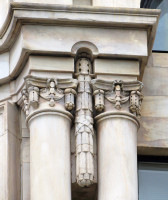
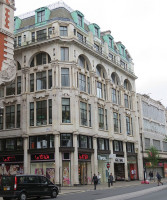
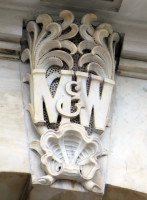
The next block after Waring and Gillow back on the north side of Oxford Street is the former Mappin and Webb building, no.158-162 Oxford Street, put up in 1906-8. It is of interest in being by the architectural partnership of Belcher and Joass (see the page on John Belcher); alas, unlike in some of his other buildings, the sculptural adornment is very small, though we may note the elegant pillar capitals and the keystones with the Mappin and Webb initials carved into them, with little stylised leaves, shells, and flowers above.
Grotesque head on no. 142-144, and details of sculpture on no. 147, the Swarovski building.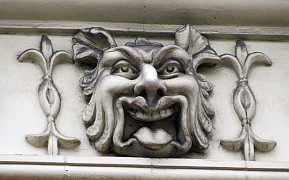
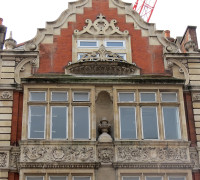
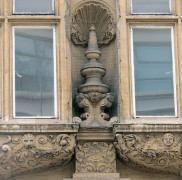
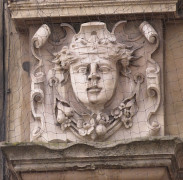
Among various of the now-familiar Queen Anneish red and white buildings, typically four storeys high with a dormer above, no. 142-144 on the north side has string courses (protruding horizontal lines of masonry) carved with stylised flowers, grotesque faces and little lion heads, (lots of architectural lion heads on this page). But the most decorated of the Queen Anne style buildings on Oxford Street is a few paces along on the south side. This is the Swarovski building, no. 147 Oxford Street, which is just two bays wide. The first floor above the modern ground floor is recessed under arches, and the next two floors come forward, Tudor fashion, on richly carved corbels; the two bays are separated with arched niches containing decorative pots. At the top, a stepped gable has some projecting balcony, pots are at the sides, above corner masonry work like pilasters going all the way to the first floor; and doubtless to the ground underneath the modern fascia. The decoration consists of all-over ornament in bands across the building, with among the low relief scrolling and acanthus leaves a variety of little moulded heads – lions, winged cherubs, grotesques, some moustouched man in a turban, a girl in a crown with a wreath of flowers around her neck,a nd so forth, along with naturalistic foliage on the corbels. A building which repays some study.
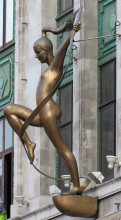
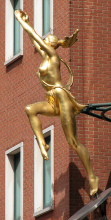 The Plaza Girl, no.120 Oxford Street, and Harrow's Golden Statue.
The Plaza Girl, no.120 Oxford Street, and Harrow's Golden Statue.
The block ends with Berwick Street to the south, and Wells Street to the north. On that north side after Wells Street then, is No. 120, the Plaza, a deco building of no sculptural interest in itself, but with upon it over the main entrance a rather nice statue of a girl springing from a small ship’s prow, holding a long ribbon which swirls around her. This statue was emplaced in 1997, and is by the sculptor Michael Rizzello. It is a curvy, modern work which reminds me of the familiar Golden Statue on the shopping centre in Harrow, West London, which can be seen from the Metropolitan line trains passing through.
Back on the south side of Oxford Street, on the eastern corner of Berwick Street is Berwick House, dated 1886, with another variation on the rounded corner leading to a spire, this time shaped rather like a downward hanging bluebell, with elegant pillars in front of recessed windows on the two floors below above the low first storey and the corner doorway. It is followed by a slightly shorter, narrower building, then almost opposite the statue of the girl on the north side, a building taller than its neighbours and covered in creamy white tile. Left and right bays have between them at the higher levels a shallow bay window going from second to fourth floor, picked out in black, recessed, and with balcony above. Gables and dormers are higher up, with various minor decoration, principally wreaths. A building that successfully looks larger and more powerful than its size.
Banister Fletcher's no. 111-125 Oxford Street (3 to left), and no. 105-109 (3 to right).
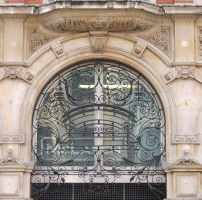
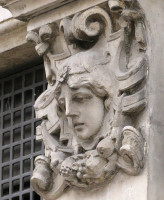
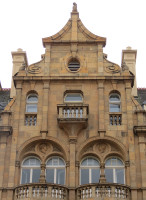
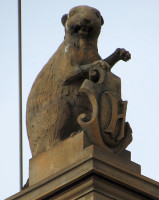
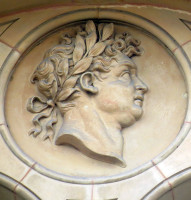
The next block on the south side, after Wardour Street, shows us the strength of the Queen Anne style when carried to some length. We have ten wide bays of a massive building, pale terra cotta at first floor and between the plate glass at ground floor, red brick and white banding on the two floors above, and then a dormer. The windows are many and arched; in twos and threes under arches on the first floor, in pairs at second floor, and individual rectangular without arches higher up. This is no. 111-125 Oxford Street, and the date is similar to Berwick House – 1887 – and the architect is Banister Fletcher, of considerable renown more as much for his writing on architecture as his buildings. The decoration is good – heads at the tops of the ground floor pilasters, with friezes above; spandrel carving above the broad arches at the first floor, and a continuous band of moulding above the second floor, together with additions above the principal entrance, including two pots in niches at the top. The next building to this one, no. 105-109 Oxford Street, in terra cotta, has different elevations to Banister Fletcher’s building, but a similar total height, and is pleasantly idiosyncratic. It was built as Heath's the Hatters, by the architects Christopher & White. Symmetrical except at roof level, with bay windows, a couple of arches and gables again, we can note roundels within the two principal arches containing profile portraits of George IV, fairly unrecognisable as a Roman emperor crowned with leaves, and Queen Victoria, with the respective dates 1822 and 1887. But the surprise comes at the top, where the skyline is improved by four terra cotta beaver statues, really rather a rare animal in British sculpture of the period.
Directly opposite that, by Newman Street on the north side of Oxford Street, another Queen Anne style building survives with a cupola and green dome, bearing an ornate bauble on the top. A bit further along on the south side, another interesting corner tower by Soho Street has recently been demolished: it was the Walton Old Queen’s Head, dated 1880, and is a loss. It had also featured a row of keystone heads at first floor level. The missing block, before rebuilding something modern, exposes the back of the French church in Soho Square.
Officers Club, no. 34-36 Oxford Street sculpture.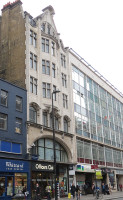
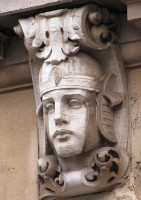
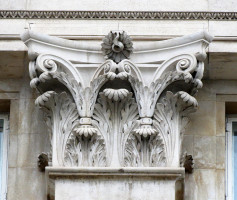
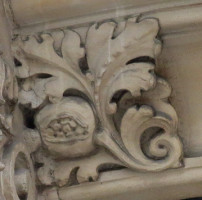
The next portion of Oxford Street going east mostly survives in its late 19th Century form, with pleasingly varied buildings, from a few years later, with one dated 1900, including a couple of the Queen Anne style. On the north side, the building above the Officers Club, nos. 34-36, is of the white stone variety, but has a single very broad arch across the full width at first floor level, and over this, and the floor above and at the top of the building, small sculptural decorations in the form of supporting brackets and hanging bosses. One of the heads is shown here, a rather splendid capital to a column, and a boss with a splitting pomegranate. Very decent decorative carving.
Varied skyline to nos. 33 and 35, and details.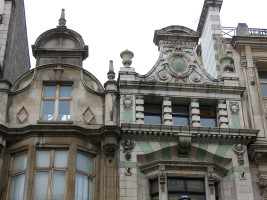
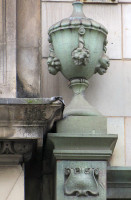
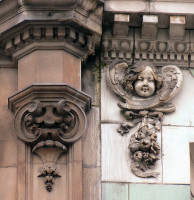
Just after this, the south side of Oxford has its final flourish in its final block, with a decent, conventional classical building at 37-39 followed by nos. 33 and 35, a pair each of just one bay wide with an excellent roofline with baroque gables and clustered chimneys. No. 35 especially really does bring a different style. It is clad in white and green tile, and incorporates free-standing pots, winged cherubic heads, corbels, cartouches and a wreath in an art nouveau 1900s style. A real asset to the street.
The final buildings on the south side before Centre Point are fairly flat, though we might note winged cherubic heads above oval shields with scrolls and hanging flowers high up. But nearly at the end on the north side of Oxford Street, we have just a couple more buildings to see. The Primark store at nos. 14-28 Oxford Street, clad in white tile, has a curved pediment, very baroque, being split entirely in two by a crisply carved shield with two torches, a busy composition including scrolls, acanthus leaves, birds, fruit and two scaly fishes at the base. Above, a winged boss and ornamental ironwork of a floral design.
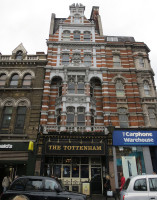
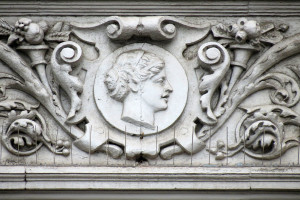
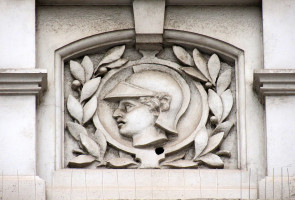 The Tottenham Pub, with two portrait heads.
The Tottenham Pub, with two portrait heads.
Finally, at the very end before Tottenham Court Road goes off to the north (and Charing Cross Road to the south), sandwiched between a stock brick Victorian building and one of the standard Queen Anne style ones, rises the Tottenham, the only pub on Oxford Street, higher than its neighbours, also in Queen Anne, but more exuberantly baroque, and decorated with floral entablatures, swirly, leafy spandrels and pediments, and little portrait heads. It was put up in 1892, and the architects were Saville and Martin.
North up Tottenham Court Road // East and north to Bloomsbury Square // Due east to Kingsway
South to Soho Square // or down Charing Cross Road // or further South to Leicester Square
Western half of Oxford Street // Regent Street
Visits to this page from 13 Mar 2014: 15,692